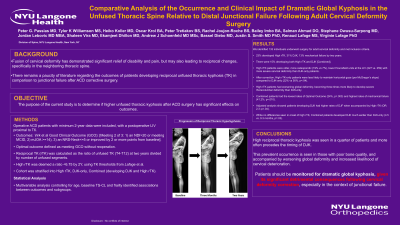Comparative Analysis of the Occurrence and Clinical Impact of Dramatic Global Kyphosis in the Unfused Thoracic Spine Relative to Distal Junctional Failure Following Adult Cervical Deformity Surgery
Friday, April 21, 2023


Peter G. Passias, MD
Spine Surgeon
NYU School of Medicine
New Canaan, CT, US
ePoster Presenter(s)
Introduction: There remains a paucity of literature regarding the outcomes of patients developing reciprocal unfused thoracic kyphosis(TK) in comparison to junctional failure after ACD corrective surgery. We examined if higher unfused thoracic kyphosis after ACD surgery has significant effects on outcomes.
Methods: Included: CD patients with up to 2Y data and LIV proximal to T6. Virk et al. Good Clinical Outcome (GCO) defined as ≥2: NDI < 20 or meeting MCID, mJOA ≥14, NRS-Neck≤5 or improved by ≥2. Optimal outcome defined as meeting GCO without reoperation. Reciprocal TK (rTK) calculated as the ratio of unfused TK(T4-T12) divided by number of unfused segments by 2Y. High rTK was deemed a ratio < 6.75 by 2Y, using TK thresholds from Lafage et al. Cohort was stratified into High rTK, DJK-only, Combined (developing DJK and High rTK). Multivariate analysis controlling for age, BL TS-CL, and frailty evaluated outcome rates between subgroups.
Results: 133 ACD patients included. Of cohort, 23% developed High rTK, 31% DJK, 13% mechanical failure. There were 15% developing both High rTK and DJK[Combined]. High rTK were older, more osteoporotic (19% vs 7%), lower Hounsfield units at the LIV(227 vs. 259) with more severe cervical deformity. After correction, High rTK-only were less likely to maintain horizontal gaze compared to DJK-only(22% vs 50%,p=.04). High rTK was three times more likely to develop severe thoracolumbar deformity than DJK-only. Combined had the lowest rates of Optimal Outcome(24%,p=.003) and highest rates of mechanical failure(41.2%,p=.010). Adjusted analysis showed patients developing DJK had higher rates of DJF when accompanied by High rTK(OR: 2.3;p=.04). While no differences seen in onset of high rTK, Combined developed DJK much earlier than DJK-only(4.5 vs. 9.3 months, p=.03).
Conclusion : High reciprocal thoracic kyphosis is seen in those with poor bone quality, is accompanied by worsening global deformity, increases likelihood of cervical deterioration, and often precedes DJK.
Methods: Included: CD patients with up to 2Y data and LIV proximal to T6. Virk et al. Good Clinical Outcome (GCO) defined as ≥2: NDI < 20 or meeting MCID, mJOA ≥14, NRS-Neck≤5 or improved by ≥2. Optimal outcome defined as meeting GCO without reoperation. Reciprocal TK (rTK) calculated as the ratio of unfused TK(T4-T12) divided by number of unfused segments by 2Y. High rTK was deemed a ratio < 6.75 by 2Y, using TK thresholds from Lafage et al. Cohort was stratified into High rTK, DJK-only, Combined (developing DJK and High rTK). Multivariate analysis controlling for age, BL TS-CL, and frailty evaluated outcome rates between subgroups.
Results: 133 ACD patients included. Of cohort, 23% developed High rTK, 31% DJK, 13% mechanical failure. There were 15% developing both High rTK and DJK[Combined]. High rTK were older, more osteoporotic (19% vs 7%), lower Hounsfield units at the LIV(227 vs. 259) with more severe cervical deformity. After correction, High rTK-only were less likely to maintain horizontal gaze compared to DJK-only(22% vs 50%,p=.04). High rTK was three times more likely to develop severe thoracolumbar deformity than DJK-only. Combined had the lowest rates of Optimal Outcome(24%,p=.003) and highest rates of mechanical failure(41.2%,p=.010). Adjusted analysis showed patients developing DJK had higher rates of DJF when accompanied by High rTK(OR: 2.3;p=.04). While no differences seen in onset of high rTK, Combined developed DJK much earlier than DJK-only(4.5 vs. 9.3 months, p=.03).
Conclusion : High reciprocal thoracic kyphosis is seen in those with poor bone quality, is accompanied by worsening global deformity, increases likelihood of cervical deterioration, and often precedes DJK.
